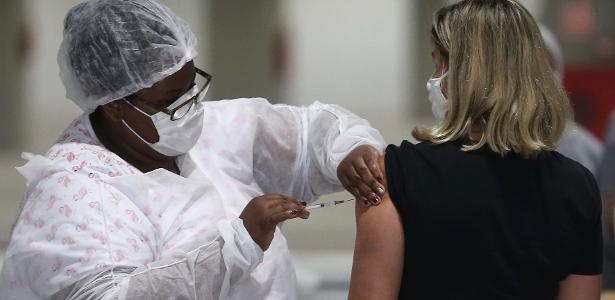In the first 24 days of June, Brazil recorded an average of one million people vaccinated against COVID-19 per day. However, in July, the demand for the second dose will grow, especially the fortifying agent of AstraZeneca, and there is no expectation that Brazil will receive enough doses to supply and maintain the same rapid pace seen in the current month
Since the vaccination campaign began until June 20, the Ministry of Health has distributed 46.6 million doses of AstraZeneca for the first application. The fortifying agent, which is manufactured by Vucrose in Brazil, requires an interval of 12 weeks between the two doses.
To complete the vaccination schedule within the time suggested in the package leaflet, it will be necessary to dispense an equivalent amount of immunizing agents for the second dose by the end of September. However, 21.3 million doses of AstraZeneca still need to be delivered for this purpose so that there is no shortfall.
The analysis was carried out by data analyst Apolinário Passos, according to the vaccination schedules issued by the Ministry of Health, with data updated until June 20.
From July to September, nearly 40 million doses of AstraZeneca must be delivered to the PNI (Plan for National Immunization), according to forecasts released by the Department of Health weekly.
In other words, of all the AstraZeneca vaccines that PNI will receive by September, at least 53% should be allocated to the second dose of those who have received the first by June 20. The analysis takes into account the distribution, not the amount of vaccine applied to the population.
It is expected that 41 million doses will be delivered in July from all laboratories to the Ministry of Health, which is a slight increase compared to 39 million doses for the entire month of June – the amount does not include donations such as The last batch of 3 million was donated From the United States to Brazil.
With this said, the trend is to fall back on the high average vaccination in the first dose to meet the demand for the second doses of AstraZeneca. There is no projection of equivalent doses from other laboratories To the record Oxford vaccine doses that were applied in June.
The situation could improve from August onwards. In August and September, the Department of Health expects to receive about 130 million doses of vaccines from all laboratories, including AstraZeneca/Oxford. Large volume can increase the vaccination rate in the first dose without delaying the closing of the vaccination schedule for those months.
The calculation of the average number of people vaccinated per day is based on data from the Press Vehicle Association, among which UOL It is a part obtained from government health departments.
Other possible scenarios
There is still potential to increase the interval between doses to keep up with speed, but experts believe it is a risky option to solve the final problem.
We have to follow the deadline for the second dose as it has been studied and researched in clinical trials. Extending is not recommended at risk of problems. This delay has already been vented into the second dose, but it is not considered acceptable anywhere in the world.”
thiago made De Oliveira is a hygienist and professor at the Catholic University of Pernambuco.
Since April, Brazil has faced some crises due to the shortage of a second dose of Coronavac – shortages of inputs and interruptions in production were the main causes.
In addition, there are records in all states of people who did not return to vaccination centers to take the second dose. For Oliveira, “the system wasn’t active enough to search for these people.”
Another possibility not to interrupt the high vaccination rate or leave people without a second dose is to mix vaccines produced in different laboratories, such as giving the second dose of Pfizer to those who received the first dose of AstraZeneca.
But studies on the vaccine mix are still being analyzed, and there is no decision or guidance from the Ministry of Health in this regard.
Threatened to “race for good”
This week, Sao Paulo faces a Display problem at stations. On Tuesday (22), ordering in the capital was suspended due to a lack of immunization – 400 out of 520 vaccination centers were without doses the day before. According to the Municipal Health Department, the reason is the high commitment in the age groups.
Since then, there has been a daily record of undisclosed publications in the capital. Friday (25), a UOL selected at least 15 jobs “Waiting to receive” doses to immunize the population.
The high demand and the problems it can generate can reduce the plans of the government. In recent weeks, in addition to the Governor of São Paulo, Joao Doria (PSDB), Governors Flávio Dino (PSB-MA) and Eduardo Leite (PSDB-RS), and Mayor of Rio de Janeiro, Eduardo Paes (PSD), used the Internet as a stage for a “healthy discussion” about who would vaccinate residents first.
Infectious disease doctor Renato Kfoury, director of the Brazilian Immunization Association, believes that the “race to the good” must take into account the entire scenario: there is no point in finishing first if less than 70% of the population has been vaccinated.
An indicator of the calendar’s progress should be that no one was left behind in the previous groups. It is not always better to vaccinate faster than to vaccinate.”
Renato Kfoury, Director of the Brazilian Society for Immunization
Thiago Oliveira agrees. For him, rapid progress runs the risk of delusion if government officials do not commit to vaccination coverage.
“What has to happen is a sure step forward, without leaving people behind, and ensuring that at least 70% of the entire target audience is closed every time the calendar moves forward.

“Wannabe internet buff. Future teen idol. Hardcore zombie guru. Gamer. Avid creator. Entrepreneur. Bacon ninja.”

